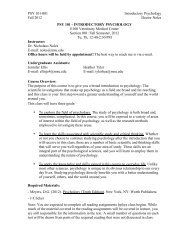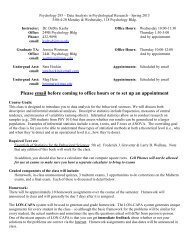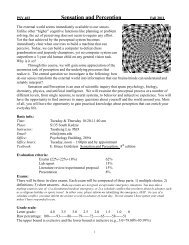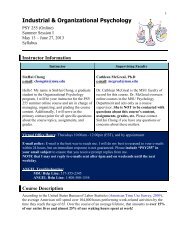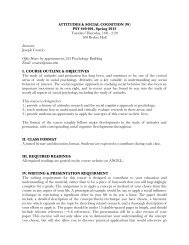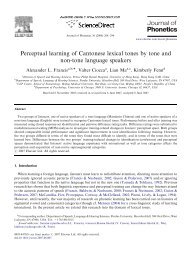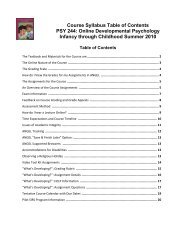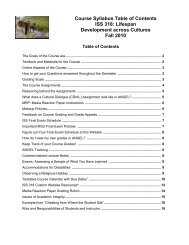STRUCTURE OF THE HYPOMANIC PERSONALITY SCALE519mogeneous nature <strong>of</strong> <strong>the</strong> Mood Volatility/Social Vitality clusters,however, <strong>the</strong> unique associations for <strong>the</strong>se clusters should beinterpreted cautiously in terms <strong>of</strong> original scale content.A second limitation is <strong>the</strong> fact that our data are not longitudinal;<strong>the</strong>refore, we do not know to what extent <strong>the</strong> subscales representpremorbid vulnerability and how <strong>the</strong>y might differentially predictaspects <strong>of</strong> bipolar spectrum disorders. This would be an importantline <strong>of</strong> future research. It is possible that only some clusters arepredictive <strong>of</strong> <strong>the</strong> development <strong>of</strong> psychopathology. Fur<strong>the</strong>rmore,some clusters (such as Excitement) may actually be negativepredictors <strong>of</strong> mental problems generally, and internalizing disordersspecifically.Although some <strong>of</strong> <strong>the</strong> HPS items reflect symptoms <strong>of</strong> mania, <strong>the</strong>bulk <strong>of</strong> its content does not assess frank symptoms <strong>of</strong> bipolardisorder; <strong>the</strong> multidimensional structure <strong>of</strong> <strong>the</strong> HPS and <strong>the</strong> variety<strong>of</strong> its correlates indicate that hypomanic personality is not synonymouswith <strong>the</strong> clinical syndrome <strong>of</strong> hypomania. Thus, ano<strong>the</strong>rlimitation <strong>of</strong> our study is that we did not include o<strong>the</strong>r measures <strong>of</strong>frank manic symptoms. Therefore, we do not know how eachsubscale may be specifically related to or predictive <strong>of</strong> mania.Although it appears from our data that Mood Volatility wouldpredict depressive episodes (and <strong>the</strong> o<strong>the</strong>r clusters would not), <strong>the</strong>relationship between mania and each cluster is unclear. Futureresearch may address <strong>the</strong> following possibilities: (a) Mood Volatilitypredicts depressive episodes, whereas Social Vitality predictsmanic episodes; (b) Mood Volatility predicts both depressive andmanic episodes, whereas Social Vitality predicts only manic episodes;(c) Mood Volatility predicts both types <strong>of</strong> bipolar episodes,but Social Vitality predicts nei<strong>the</strong>r; and (d) Mood Volatility andSocial Vitality predict different aspects <strong>of</strong> mania. We suspect thatExcitement might predict manic episodes at <strong>the</strong> zero-order levelbut that it would not predict mania (and may even be a negativepredictor) once its shared variance with Mood Volatility is removed.Finally, our sample, though large, was drawn from a nonclinicaland relatively well-adjusted and homogeneous population. Although<strong>the</strong> sample size may have resulted in relatively large rangeswith respect to personality variables and internalizing symptoms,<strong>the</strong> variability for externalizing behavior may have been limited.As indicated earlier, compared with a sample drawn from a communityor clinical population, our sample was probably limited to<strong>the</strong> extent that externalizing behavior was socially and physicallydangerous or o<strong>the</strong>rwise dysfunctional.ReferencesAkiskal, K. K., & Akiskal, H. S. (2005). The <strong>the</strong>oretical underpinnings <strong>of</strong>affective temperaments: Implications for evolutionary foundations <strong>of</strong>bipolar disorder and human nature. Journal <strong>of</strong> Affective Disorders, 85,231–239. doi:10.1016/j.jad.2004.08.002American Psychiatric Association. (2000). Diagnostic and statistical manual<strong>of</strong> mental disorders. (4th ed., text rev.). Washington, DC: Author.Bacon, D. (2001). An evaluation <strong>of</strong> cluster analytic approaches to initialmodel specification. Structural Equation Modeling, 8, 397–429. doi:10.1207/S15328007SEM0803_4Beck, A. T., Epstein, N., Brown, G., & Steer, R. A. (1988). An inventoryfor measuring clinical anxiety: Psychometric properties. Journal <strong>of</strong>Consulting and Clinical Psychology, 56, 893–897. doi:10.1037/0022-006X.56.6.893Blagov, P. S., Fowler, K. A., & Lilienfeld, S. O. (2007). Histrionicpersonality disorder. In W. O’Donohue, K. A. Fowler, & S. O. Lilienfeld(Eds.), <strong>Personality</strong> disorders: Toward <strong>the</strong> DSM–V (pp. 203–232). ThousandOaks, CA: Sage.Carver, C. S., & White, T. L. (1994). Behavioral inhibition, behavioralactivation, and affective responses to impending reward and punishment:The BIS/BAS scales. Journal <strong>of</strong> <strong>Personality</strong> and Social Psychology, 67,319–333. doi:10.1037/0022-3514.67.2.319Cattell, R. B. (1966). The scree test for <strong>the</strong> number <strong>of</strong> factors. MultivariateBehavioral Research, 1, 245–276. doi:10.1207/s15327906mbr0102_10Clark, L. A. (1993). Manual for <strong>the</strong> Schedule for Nonadaptive and Adaptive<strong>Personality</strong>. Minneapolis, MN: University <strong>of</strong> Minnesota Press.Clark, L. A. (2005). Temperament as a unifying basis for personality andpsychopathology. Journal <strong>of</strong> Abnormal Psychology, 114, 505–521. doi:10.1037/0021-843X.114.4.505Clark, L. A., Watson, D., & Mineka, S. (1994). Temperament, personality,and <strong>the</strong> mood and anxiety disorders. Journal <strong>of</strong> Abnormal Psychology,103, 103–116. doi:10.1037/0021-843X.103.1.103Cooksey, R. W., & Soutar, G. N. (2006). Coefficient beta and hierarchicalitem clustering: An analytical procedure for establishing and displaying<strong>the</strong> dimensionality and homogeneity <strong>of</strong> summated scales. OrganizationalResearch Methods, 9, 78–98. doi:10.1177/1094428105283939Depue, R. A., & Iacono, W. G. (1989). Neurobehavioral aspects <strong>of</strong> affectivedisorders. Annual Review <strong>of</strong> Psychology, 40, 457–492.DeYoung, C. G., Quilty, L. C., & Peterson, J. B. (2007). Between facetsand domains: 10 aspects <strong>of</strong> <strong>the</strong> Big Five. Journal <strong>of</strong> <strong>Personality</strong> andSocial Psychology, 93, 880–896. doi:10.1037/0022-3514.93.5.880Divgi, D. R. (1979). Calculation <strong>of</strong> <strong>the</strong> tetrachoric correlation coefficient.Psychometrika, 44, 169–172. doi:10.1007/BF02293968Durbin, C. E., Schalet, B. D., Hayden, E. P., Simpson, J., & Jordan, P. L.(2009). <strong>Hypomanic</strong> personality traits: A multi-method exploration <strong>of</strong><strong>the</strong>ir association with normal and abnormal dimensions <strong>of</strong> personality.Journal <strong>of</strong> Research in <strong>Personality</strong>, 43, 898–905. doi:10.1016/j.jrp.2009.04.010Eckblad, M., & Chapman, L. J. (1986). Development and validation <strong>of</strong> ascale for hypomanic personality. Journal <strong>of</strong> Abnormal Psychology, 95,214–222. doi:10.1037/0021-843X.95.3.214Ferguson, G. (1941). The factorial interpretation <strong>of</strong> test difficulty. Psychometrika,6, 323–329. doi:10.1007/BF02288588Fox, J. (2010). polycor: Polychoric and polyserial correlations (R PackageVersion 0.7–8) [Computer s<strong>of</strong>tware]. Retrieved from http://CRAN.Rproject.org/packagepolycorFurnham, A., Batey, M., Anand, K., & Manfield, J. (2008). <strong>Personality</strong>,hypomania, intelligence and creativity. <strong>Personality</strong> and Individual Differences,44, 1060–1069. doi:10.1016/j.paid.2007.10.035Glisky, M. L., Tataryn, D. J., Tobias, B. A., Kihlstrom, J. F., & McConkey,K. M. (1991). Absorption, openness to experience, and hypnotizability.Journal <strong>of</strong> <strong>Personality</strong> and Social Psychology, 60, 263–272. doi:10.1037/0022-3514.60.2.263Goldberg, L. R. (1993). The structure <strong>of</strong> phenotypic personality traits.American Psychologist, 48, 26–34. doi:10.1037/0003-066X.48.1.26Gray, J. A., & McNaughton, N. (2000). The neuropsychology <strong>of</strong> anxiety:An enquiry into <strong>the</strong> functions <strong>of</strong> <strong>the</strong> sept-hippocampal system (2nd ed.).Oxford, England: Oxford University Press.Guttman, L. (1954). Some necessary conditions for common-factor analysis.Psychometrika, 19, 149–161. doi:10.1007/BF02289162Harlan, E., & Clark, L. A. (1999). Short-forms <strong>of</strong> <strong>the</strong> Schedule forNonadaptive and Adaptive <strong>Personality</strong> (SNAP) for self and collateralratings: Development, reliability, and validity. Assessment, 6, 131–145.doi:10.1177/107319119900600203Hoyle, R. H., Fejfar, M. C., & Miller, J. D. (2000). <strong>Personality</strong> and sexualrisk taking: A quantitative review. Journal <strong>of</strong> <strong>Personality</strong>, 68, 1203–1231. doi:10.1111/1467-6494.00132Johnson, S. L. (2005). Mania and dysregulation <strong>of</strong> goal pursuit: A review.
520 SCHALET, DURBIN, AND REVELLEClinical Psychology Review, 25, 241–262. doi:10.1016/j.cpr.2004.11.002Kaiser, H. F. (1960). The application <strong>of</strong> electronic computers to factoranalysis. Educational and Psychological Measurement, 20, 141–151.doi:10.1177/001316446002000116Kendler, K. S., Kuhn, J., & Prescott, C. A. (2004). The interrelationship <strong>of</strong>neuroticism, sex, and stressful life events in <strong>the</strong> prediction <strong>of</strong> episodes <strong>of</strong>major depression. American Journal <strong>of</strong> Psychiatry, 161, 631–636. doi:10.1176/appi.ajp.161.4.631Kendler, K. S., Prescott, C. A., Myers, J., & Neale, M. C. (2003). Thestructure <strong>of</strong> genetic and environmental risk factors for common psychiatricand substance use disorders in men and women. Archives <strong>of</strong>General Psychiatry, 60, 929–937. doi:10.1001/archpsyc.60.9.929Klein, D. N., Durbin, C. E., & Shankman, S. (2009). <strong>Personality</strong> and mooddisorders. In I. H. Gotlib & C. L. Hammen (Eds.), Handbook <strong>of</strong> depression(2nd ed., pp. 93–112). New York, NY: Guilford Press.Klein, D. N., Lewinsohn, P. M., & Seeley, J. R. (1996). <strong>Hypomanic</strong>personality traits in a community sample <strong>of</strong> adolescents. Journal <strong>of</strong>Affective Disorders, 38, 135–143. doi:10.1016/0165-0327(96)00005-5Krueger, R. F. (1999). The structure <strong>of</strong> common mental disorders. Archives<strong>of</strong> General Psychiatry, 56, 921–926. doi:10.1001/archpsyc.56.10.921Krumm-Merabet, C., & Meyer, T. D. (2005). Leisure activities, alcohol,and nicotine consumption in people with a hypomanic/hyperthymictemperament. <strong>Personality</strong> and Individual Differences, 38, 701–712. doi:10.1016/j.paid.2004.05.024Kwapil, T. R., Miller, M. B., Zinser, M. C., Chapman, L. J., Chapman, J.,& Eckblad, M. (2000). A longitudinal study <strong>of</strong> high scorers on <strong>the</strong><strong>Hypomanic</strong> <strong>Personality</strong> <strong>Scale</strong>. Journal <strong>of</strong> Abnormal Psychology, 109,222–226. doi:10.1037/0021-843X.109.2.222Lance, C., Butts, M., & Michels, L. (2006). The sources <strong>of</strong> four commonlyreported cut<strong>of</strong>f criteria: What did <strong>the</strong>y really say? Organizational ResearchMethods, 9, 202–220. doi:10.1177/1094428105284919Lozano, B. E., & Johnson, S. L. (2001). Can personality traits predictincreases in manic and depressive symptoms? Journal <strong>of</strong> AffectiveDisorders, 63, 103–111. doi:10.1016/S0165-0327(00)00191-9Lynam, D. R., Hoyle, R. H., & Newman, J. P. (2006). The perils <strong>of</strong>partialling: Cautionary tales from aggression and psychopathy. Assessment,13, 328–341. doi:10.1177/1073191106290562Markon, K. E., Krueger, R. F., & Watson, D. (2005). Delineating <strong>the</strong>structure <strong>of</strong> normal and abnormal personality: An integrative hierarchicalapproach. Journal <strong>of</strong> <strong>Personality</strong> and Social Psychology, 88, 139–157. doi:10.1037/0022-3514.88.1.139Meads, D. M., & Bentall, R. P. (2008). Rasch analysis and item reduction<strong>of</strong> <strong>the</strong> <strong>Hypomanic</strong> <strong>Personality</strong> <strong>Scale</strong>. <strong>Personality</strong> and Individual Differences,44, 1772–1783. doi:10.1016/j.paid.2008.02.009Meyer, B., Johnson, S. L., & Carver, C. S. (1999). Exploring behavioralactivation and inhibition sensitivities among college students at risk forbipolar-spectrum symptomatology. Journal <strong>of</strong> Psychopathology and BehavioralAssessment, 21, 275–292. doi:10.1023/A:1022119414440Meyer, B., Johnson, S. L., & Winters, R. (2001). Responsiveness to threatand incentive in bipolar disorder: Relations <strong>of</strong> <strong>the</strong> BIS/BAS scales withsymptoms. Journal <strong>of</strong> Psychopathology and Behavioral Assessment, 23,133–143. doi:10.1023/A:1010929402770Meyer, B., Rahman, R., & Shepherd, R. (2007). <strong>Hypomanic</strong> personalityfeatures and addictive tendencies. <strong>Personality</strong> and Individual Differences,42, 801–810. doi:10.1016/j.paid.2006.08.024Meyer, T. D. (2002). The <strong>Hypomanic</strong> <strong>Personality</strong> <strong>Scale</strong>, <strong>the</strong> Big Five, and<strong>the</strong>ir relationship to depression and mania. <strong>Personality</strong> and IndividualDifferences, 32, 649–660. doi:10.1016/S0191-8869(01)00067-8Meyer, T. J., Miller, M. L., Metzger, R. L., & Borkovec, T. D. (1990).Development and validation <strong>of</strong> <strong>the</strong> Penn State Worry Questionnaire.Behaviour Research and Therapy, 28, 487–495. doi:10.1016/0005-7967(90)90135-6Miller, G. A., & Chapman, J. P. (2001). Misunderstanding analysis <strong>of</strong>covariance. Journal <strong>of</strong> Abnormal Psychology, 110, 40–48. doi:10.1037/0021-843X.110.1.40Millon, T. (1987). Millon Clinical Multiaxial Inventory–II, manual(MCMI-II) (2nd ed.). Minneapolis, MN: National Computer Systems.Morey, L. C., Warner, M. B., Shea, M., Gunderson, J. G., Sanislow, C. A.,Grilo, C., . . . McGlashan, T. H. (2003). The representation <strong>of</strong> fourpersonality disorders by <strong>the</strong> Schedule for Nonadaptive and Adaptive<strong>Personality</strong> dimensional model <strong>of</strong> personality. Psychological Assessment,15, 326–332. doi:10.1037/1040-3590.15.3.326Ormel, J., Oldehinkel, A. J., & Vollebergh, W. (2004). Vulnerabilitybefore, during, and after a major depressive episode: A 3-wavepopulation-based study. Archives <strong>of</strong> General Psychiatry, 61, 990–996.doi:10.1001/archpsyc.61.10.990Panter, A. T., Swygert, K. A., Dahlstrom, W. G., & Tanaka, J. S. (1997).Factor analytic approaches to personality item-level data. Journal <strong>of</strong><strong>Personality</strong> Assessment, 68, 561–589. doi:10.1207/s15327752jpa6803_6Patrick, C. J., Curtin, J., & Tellegen, A. (2002). Development and validation<strong>of</strong> a brief form <strong>of</strong> <strong>the</strong> <strong>Multidimensional</strong> <strong>Personality</strong> Questionnaire.Psychological Assessment, 14, 150–163. doi:10.1037/1040-3590.14.2.150Paulhus, D. L., Robins, R. W., Trzesniewski, K. H., & Tracy, J. L. (2004).Two replicable suppressor situations in personality research. MultivariateBehavioral Research, 39, 303–328. doi:10.1207/s15327906mbr3902_7Rawlings, D., Barrantes-Vidal, N., Claridge, G., McCreery, C., & Galanos,G. (2000). A factor analytic study <strong>of</strong> <strong>the</strong> <strong>Hypomanic</strong> <strong>Personality</strong> <strong>Scale</strong> inBritish, Spanish and Australian samples. <strong>Personality</strong> and IndividualDifferences, 28, 73–84. doi:10.1016/S0191-8869(99)00081-1R Core Development Team. (2010). R: A language and environment forstatistical computing [Computer s<strong>of</strong>tware]. Vienna, Austria: R Foundationfor Statistical Computing. Retrieved from http://www.Rproject.org/Revelle, W. (1979). Hierarchical cluster-analysis and <strong>the</strong> internal structure<strong>of</strong> tests. Multivariate Behavioral Research, 14, 57–74. doi:10.1207/s15327906mbr1401_4Revelle, W. (2009). psych: Procedures for personality and psychologicalresearch (R Package Version 1.0-73) [Computer s<strong>of</strong>tware]. Evanston, IL:Northwestern University. Retrieved from http://cran.opensourceresources.org/web/packages/psych/psych.pdfRevelle, W., & Rocklin, T. (1979). Very simple structure: An alternativeprocedure for estimating <strong>the</strong> optimal number <strong>of</strong> interpretable factors.Multivariate Behavioral Research, 14, 403–414.Revelle, W., & Zinbarg, R. E. (2009). Coefficients alpha, beta, omega, and<strong>the</strong> glb: Comments on Sijtsma. Psychometrika, 74, 145–154. doi:10.1007/s11336-008-9102-zRo, E., & Clark, L. (2009). Psychosocial functioning in <strong>the</strong> context <strong>of</strong>diagnosis: Assessment and <strong>the</strong>oretical issues. Psychological Assessment,21, 313–324. doi:10.1037/a0016611Samuel, D. B., & Widiger, T. A. (2008). A meta-analytic review <strong>of</strong> <strong>the</strong>relationships between <strong>the</strong> five-factor model and DSM–IV–TR personalitydisorders: A facet level analysis. Clinical Psychology Review, 28, 1326–1342. doi:10.1016/j.cpr.2008.07.002Saucier, G. (1994). Mini-Markers: A brief version <strong>of</strong> Goldberg’s unipolarBig-Five markers. Journal <strong>of</strong> <strong>Personality</strong> Assessment, 63, 506–516.doi:10.1207/s15327752jpa6303_8Saulsman, L. M., & Page, A. C. (2004). The five-factor model andpersonality disorder empirical literature: A meta-analytic review. ClinicalPsychology Review, 23, 1055–1085. doi:10.1016/j.cpr.2002.09.001Schmid, J. J., & Leiman, J. M. (1957). The development <strong>of</strong> hierarchicalfactor solutions. Psychometrika, 22, 53–61. doi:10.1007/BF02289209Shahar, G., Scotti, M.-A., Rudd, M. D., & Joiner, T. E. (2008). <strong>Hypomanic</strong>symptoms predict an increase in narcissistic and histrionic personalitydisorder features in suicidal young adults. Depression and Anxiety, 25,892–898. doi:10.1002/da.20363
- Page 1 and 2: Psychological Assessment© 2011 Ame
- Page 3 and 4: 506 SCHALET, DURBIN, AND REVELLETab
- Page 5 and 6: 508 SCHALET, DURBIN, AND REVELLEite
- Page 7 and 8: 510 SCHALET, DURBIN, AND REVELLETab
- Page 9 and 10: 512 SCHALET, DURBIN, AND REVELLETat
- Page 11 and 12: 514 SCHALET, DURBIN, AND REVELLETab
- Page 13 and 14: 516 SCHALET, DURBIN, AND REVELLEp
- Page 15: 518 SCHALET, DURBIN, AND REVELLESoc
- Page 19: 522 SCHALET, DURBIN, AND REVELLEApp




